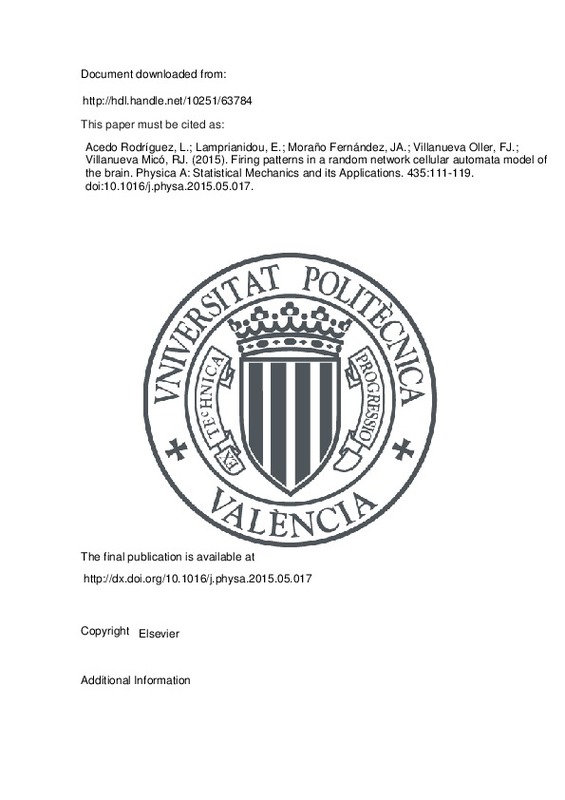JavaScript is disabled for your browser. Some features of this site may not work without it.
Buscar en RiuNet
Listar
Mi cuenta
Estadísticas
Ayuda RiuNet
Admin. UPV
Firing patterns in a random network cellular automata model of the brain
Mostrar el registro sencillo del ítem
Ficheros en el ítem
| dc.contributor.author | Acedo Rodríguez, Luis
|
es_ES |
| dc.contributor.author | Lamprianidou, Erasmia
|
es_ES |
| dc.contributor.author | Moraño Fernández, José Antonio
|
es_ES |
| dc.contributor.author | Villanueva Oller, Francisco Javier
|
es_ES |
| dc.contributor.author | Villanueva Micó, Rafael Jacinto
|
es_ES |
| dc.date.accessioned | 2016-05-09T11:31:42Z | |
| dc.date.available | 2016-05-09T11:31:42Z | |
| dc.date.issued | 2015-10 | |
| dc.identifier.issn | 0378-4371 | |
| dc.identifier.uri | http://hdl.handle.net/10251/63784 | |
| dc.description.abstract | One of the main challenges in the simulation of even reduced areas of the brain is the presence of a large number of neurons and a large number of connections among them. Even from a theoretical point of view, the behaviour of dynamical models of complex networks with high connectivity is unknown, precisely because the cost of computation is still unaffordable and it will likely be in the near future. In this paper we discuss the simulation of a cellular automata network model of the brain including up to one million sites with a maximum average of three hundred connections per neuron. This level of connectivity was achieved thanks to a distributed computing environment based on the BOINC (Berkeley Open Infrastructure for Network Computing) platform. Moreover, in this work we consider the interplay among excitatory neurons (which induce the excitation of their neighbours) and inhibitory neurons (which prevent resting neurons from firing and induce firing neurons to pass to the refractory state). Our objective is to classify the normal (noisy but asymptotically constant patterns) and the abnormal (high oscillations with spindle-like behaviour) patterns of activity in the model brain and their stability and parameter ranges in order to determine the role of excitatory and inhibitory compensatory effects in healthy and diseased individuals. | es_ES |
| dc.language | Inglés | es_ES |
| dc.publisher | Elsevier | es_ES |
| dc.relation.ispartof | Physica A: Statistical Mechanics and its Applications | es_ES |
| dc.rights | Reserva de todos los derechos | es_ES |
| dc.subject | Networks dynamics | es_ES |
| dc.subject | Cellular automata | es_ES |
| dc.subject | EEG | es_ES |
| dc.subject | Random networks | es_ES |
| dc.subject.classification | MATEMATICA APLICADA | es_ES |
| dc.title | Firing patterns in a random network cellular automata model of the brain | es_ES |
| dc.type | Artículo | es_ES |
| dc.identifier.doi | 10.1016/j.physa.2015.05.017 | |
| dc.rights.accessRights | Abierto | es_ES |
| dc.contributor.affiliation | Universitat Politècnica de València. Departamento de Matemática Aplicada - Departament de Matemàtica Aplicada | es_ES |
| dc.description.bibliographicCitation | Acedo Rodríguez, L.; Lamprianidou, E.; Moraño Fernández, JA.; Villanueva Oller, FJ.; Villanueva Micó, RJ. (2015). Firing patterns in a random network cellular automata model of the brain. Physica A: Statistical Mechanics and its Applications. 435:111-119. doi:10.1016/j.physa.2015.05.017 | es_ES |
| dc.description.accrualMethod | S | es_ES |
| dc.relation.publisherversion | http://dx.doi.org/10.1016/j.physa.2015.05.017 | es_ES |
| dc.description.upvformatpinicio | 111 | es_ES |
| dc.description.upvformatpfin | 119 | es_ES |
| dc.type.version | info:eu-repo/semantics/publishedVersion | es_ES |
| dc.description.volume | 435 | es_ES |
| dc.relation.senia | 294926 | es_ES |







![[Cerrado]](/themes/UPV/images/candado.png)

